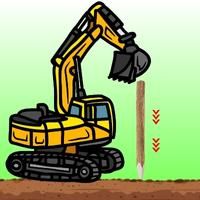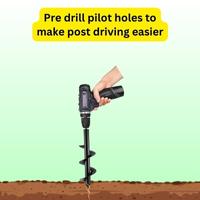Typically, wooden posts are installed by digging holes & setting them in concrete. However, it’s possible to avoid all the hassle of digging by using sharp-ended wood posts and driving them with post-driving tools. We can use different post-driving tools depending on availability, budget, number of posts & the ground hardness.
We can use a heavy metal pipe or a manual post driver to drive a few posts. Using an automatic post driver or a tractor/loader bucket, you can drive more posts with less effort. However, ensure that one end of the posts is sharp as the thick base won’t drive into the ground.
In this post, we’ll discuss all tools & tips to drive wood posts into the ground. Make sure to read the complete guide:
How to drive a wooden post into the ground?
- Mark the spots where wood posts will be driven. Analyze the number of posts & the ground conditions to choose the right tool.
- Use a heavy metal pipe or a post driver for driving a few wood posts on the soft ground.
- However, an automatic (electric) post driver is particularly helpful on hard surfaces as it requires significantly less time & energy.
- In rocky ground, dig a hole to check for hard rock layers and make the post-driving easier. You can use an auger drill or manual digging tools, such as a post-hole digger or shovel, to accomplish this task.
- As an alternative to post-driving tools, tractors, loaders, and excavators equipped with buckets can be used to drive posts effortlessly.
Tips:
- Use a Level tool to keep the post level.
- Wood posts are heavy, so you must keep someone for assistance.
Follow the step-by-step guide below:
Tool Required:
- Wood posts: Choose sturdy, pressure-treated lumber posts, sharp from one end 3 feet larger than your fence height.
- A trowel to clear the ground
- An auger drill to drill pilot holes(predrilled).
- Post driver: This can be a heavy metal pipe, manual, electric, hydraulic post driver, or tractor/loader equipped with a bucket. Ensure the post driver is larger than the wood post’s diameter.
- Level Tools: The level is used to ensure the post is straight.
- Hammer: A large mallet or sledgehammer will work and can also help drive thinner wood posts on soft ground.
Step 1: Choose the right post driver
You can use different post drivers according to the wood post’s diameter(size), the ground hardness, & availability.
Tool 1: Manual post-driver
A heavy-duty manual post driver is useful for driving thin wood posts of a maximum diameter of 4 inches. However not ideal for thick wood posts. The process would be slower and require a lot of manual effort. So, you must be physically fit to lift & pound the post driver continuously.
In soft ground, driving wood posts would be easier. However, in the summer seasons, the ground gets hard due to low moisture. Hence, driving wood posts with a manual driver may become almost impossible.
Hence, a manual post driver is not recommended for driving a large number of or thicker wood posts, especially if the ground is hard.
Tip: To use a manual post driver, watering the ground is helpful to loosen the hard ground. Or pre-drill pilot holes(thin holes), at least up to a foot. As the main hurdle is to drive the posts up to a foot because moisture increases deep in the soil.
Steps to use a manual post driver:
- Simply place the manual post driver over the fence post, lift/push it up, and pull (pound) it downward.
- Repeat the lifting and dropping motion until the post reaches the desired depth.
Tool 2: Automatic(electric) post-driver:
An automatic post driver is a powerful tool to drive a large number of heavy wood posts in any type of soil. However, if the ground is rocky or extremely hard, it’s better to drill pilot holes.
Simply align the wood post vertically straight. Place the automatic post driver over the wood post. Turn the driver on and slightly keep pulling it downward.
Tool 3: Tractor/loader or excavator equipped with a bucket
Besides a manual or electric post driver, you can use a tractor or loader equipped with a bucket to drive fence posts. Ask someone to hold the post vertically straight. Hit the tractor’s bucket from the exact top of the posts. Then, lift the bucket up & hit it again.
Tool 4: Hydraulic post driver
A hydraulic post driver is the most heavy-duty tool for driving thick, heavy wood posts. They are ideal, especially for large-area fencing & for the hard ground. They usually get mounted to mini tractors(loaders), excavators, or skid steers.
However, it’s not suitable to buy a hydraulic post driver for a single DIY fencing project. So it’s better to borrow or rent it for a day.
Step 2: Decide post spacing
Generally, wood posts can be spaced 6-25 feet apart, depending on the soil condition, animal load, the weight of the fence & the desired strength of the fixture.
How deep to bury the fence post?
As per rules & recommendations, bury ⅓rd of the total height of the fence posts. For example, A 4-foot (48 inches) fence post should be driven up to 16 inches (1/3rd).
After deciding the post spacing, mark spots at regular intervals to drill pilot holes or drive posts directly. Also, mark the length of posts that will go underground.
Step 3: Prepare the site & drill pilot holes
Clear the spots where you want to drive posts by removing debris & leaves using a trowel or similar tool.
If the ground is rocky, it’s better to pre-drill holes (pilot holes) using an auger drill to make the post-driving (installation) easier. A 2-inch auger bit would be helpful.
Step 4(Last): Position & drive the posts
Hold the wooden post vertically straight over the marked spot or the pilot hole. Keep the sharp end of the wood post downward. After that, place your post driver over the flat top of the wooden post & drive it up to a few inches.
Then, use a level tool to check whether the posts are straight or inclined. If required, push/pull them in the right direction. At last, use your post driver to drive the posts completely up to the mark.
Posts may not drive completely if hard rock layers are in the ground. In such cases, choose a spot a couple of feet.
Verify the stability:
After the post is driven to your desired depth, check its stability by pushing or pulling it. If the pots are still
Frequently Asked Questions
- How to drive wooden fence posts by hand?
If you don’t have a post-driving tool, you can use a mallet or a fencing maul. Ask someone to hold the post & you hit it with the mallet/ fencing maul from the top while standing at a height.
- How to drive wood fence posts with a front-end loader?
Pre-drill pilot holes & ask someone to hold the wood post straight. Position the tractor/loader’s bucket exactly over the wood post. Hit the bucket to the posts, then lift it up & hit again. Repeat until the ⅓rd of the post is driven.
- How to drive t-posts?
The same tools are used to drive wood posts & metal posts i.e. t-posts. As T-posts are lightweight & have a sharp anchor at the bottom, a manual post driver is enough for this purpose. However, for driving more T-posts & on the hard ground, you can use an electric or hydraulic post driver or a tractor excavator equipped with a bucket.
- How do you anchor a post without digging it?
To avoid digging, fence post anchors can be used to hold the fence. Fence post anchors(spike) get driven into the ground. While the bracket holds the fence post. In this way, you’ll have removable fence posts without digging anchored to the ground.
As discussed in the post, to prevent digging, you can also use sharp-end wood posts & drive them with a post driver.
Conclusion
To drive wood posts directly without digging, ensure they are sharp from one end. Then, choose an appropriate tool for driving posts. The best tool for driving wood posts is an automatic post driver. It seeks very little effort.
A manual post driver is also useful in driving a few thin wood posts on soft ground, as it requires a lot of power in lifting & pounding. That’s why you should only use a manual post driver to install a few fence posts.
However, a tractor or loader equipped with a bucket or a hydraulic post driver mounted on a tractor is the most heavy-duty tool for driving a large number of thick wood posts on any type of ground.
However, pre-drill pilot holes to make post-driving easier & check if there are rock layers underground.
If you still need assistance, ask us in the comments below.
Related Guides:





